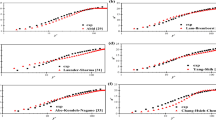Abstract
Satisfactory scaling from laboratory-scale pipe-flow data to large industrial pipelines is an area of practical concern in the utilization of drag-reducing polymer solutions. From experimental data for pipes 0.0254 m in diameter and above, it is shown that accurate scaling can be obtained using a simple, pocket-calculator method. However, pipes of say, 0.005 m and smaller provide much less accurate scaling data for larger pipes. A detailed study of the velocity profiles in drag-reducing flow indicates a total lack of similarity of the profiles of the very small pipes compared with the larger.
Similar content being viewed by others
Abbreviations
- A,B :
-
constants in velocity profile equation
- ΔB :
-
constant indicating drag reduction
- D:
-
pipe diameter, m
- k:
-
Karman constant (reciprocal of A)
- k s :
-
height of sand-type roughness, m
- N :
-
nondimensional negative roughness parameter
- Re :
-
Reynolds number, UD/v
- U :
-
average velocity in pipe, m/sec
- u + :
-
local velocity in pipe, nondimensionalized with u *
- u * :
-
friction velocity, m/sec
- y :
-
radial distance from pipe wall, m
- y + :
-
nondimensional distance from wall, yu * /v
- λ :
-
Darcy friction factor
- v :
-
kinematic viscosity, m2/sec
- 1:
-
experimental data
- 2:
-
predicted
References
Bewersdorff, H.-W.; Ohlendorf, D. 1985: The influence of drag reducing surfactants on the structure of turbulence in pipe flow. In: Turbulent shear flows 5 (ed. Lumley, J. L.) pp. 9.41–46. Ithaca: Cornell University
Burger, E.; Munk, W.; Wahl, H. 1981: Flow increase in the Trans Alaska Pipeline using a polymeric drag reducing additive. Society of Petroleum Engineers: SPE 9419
Elata, C.; Lehrer, J.; Kahanovitz, A. 1966: Turbulent shear flow of polymer solutions. Isr. J. Technology 4, 87–95
Granville, P. 1977: Scaling-up of pipe-flow frictional data for drag-reducing polymer solutions. In: 2nd Int. Conf. on Drag Reduction, (eds. Stevens, H. S.; Clarke, J. A.), pp. B1–1–12. Cranfield: BHRA Fluid Engineering
Granville, P. 1984: A method for predicting additive drag reduction for small-diameter pipe-flow. In: 3rd Int. Conf. on Drag Reduction, (eds. Sellin, R. H. J.: Moses, R. T.), pp. C.3–1–8. Bristol: University of Bristol
Hoyt, J. 1991: “Negative roughness” and polymer drag reduction. Exp. Fluids 11, 142–146
Lester, C. 1985: The basics of drag reduction. Oil & Gas Journal 83, No. 5, 51–56
Matthys, E.; Sabersky, R. 1982: A method of predicting the “diameter effect” for heat transfer and friction of drag-reducing fluids. Int. J. Heat Mass Transfer 25, 1343 51
Meyer, W. 1966: A correlation of the frictional characteristics for turbulent flow of dilute viscoelastic non-Newtonian fluids in pipes. AIChE J. 12, 522–525
Savins, J.; Seyer, F. 1977: Drag-reduction scale-up criteria. Phys. Fluids 20, S78-S84
Sellin, R.; Ollis, M. 1983: Effect of pipe diameter on polymer drag reduction. I & EC, Product R & D 22, 445–452
Virk, P. 1971: An elastic sublayer model for drag reduction by dilute solutions of linear macromolecules. J. Fluid Mech. 45, 417–40
White, F. 1991: Viscous fluid flow. 2nd ed. New York: McGraw-Hill
Author information
Authors and Affiliations
Rights and permissions
About this article
Cite this article
Hoyt, J.W., Sellin, R.H.J. Scale effects in polymer solution pipe flow. Experiments in Fluids 15, 70–74 (1993). https://doi.org/10.1007/BF00195598
Received:
Accepted:
Issue Date:
DOI: https://doi.org/10.1007/BF00195598




